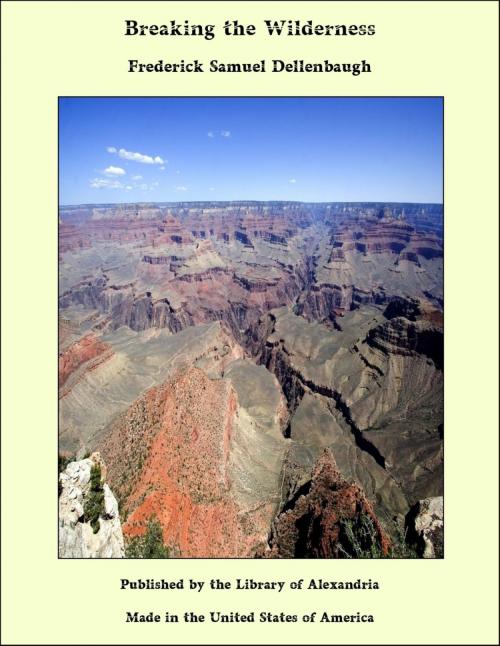| Author: | Frederick Samuel Dellenbaugh | ISBN: | 9781465624277 |
| Publisher: | Library of Alexandria | Publication: | March 8, 2015 |
| Imprint: | Language: | English |
| Author: | Frederick Samuel Dellenbaugh |
| ISBN: | 9781465624277 |
| Publisher: | Library of Alexandria |
| Publication: | March 8, 2015 |
| Imprint: | |
| Language: | English |
The natural habitat of man is the wilderness. No matter how civilised he may become, his heart turns with longing to the woods, to the sea, and to the mountains. There he is unconventional; animals are his compeers, the forest his friend, the free-flowing stream nectar to his lips. Civilised peoples, after all, are but wanderers driven from the Garden of Eden by the sword of necessity. Of the virtues they claim, a large proportion is imperative, the result of conflicting numbers—society's effort to preserve itself. Men are no better, no worse, in the wilderness or in civilisation; nor does race or colour appear exactly to define quality. By noting this at the outset we may be inclined to be more sympathetic; and therefore may better understand the superb wilderness which forms the subject of this work. Nearly two-thirds of the entire present area of the United States was comprised in it, extending between the north and south bounds of the Union, from the Mississippi on the one hand, to the Pacific on the other; a vast region of marvellous diversity, greater far than several of the Old-World empires rolled into one. Up to the hour when the Santa Maria flung her parting banners out and under the steady will of the Admiral moved upon the Western Mystery, no European had ever beheld the wide horizon of this splendid realm, nor yet even dreamed of it, for whatever in the way of exploration prior to Columbus the Northmen may have accomplished on the Atlantic coast of America, we may be sure not one of them ever set foot beyond the banks of the Father of Waters. And so this land, unknown to Europeans, remained unknown till the year when Alvar Nuñez Cabeza de Vaca, escaping from the terrible disasters of the Narvaez Florida expedition, in his enforced long wanderings, crossed the lower margin, now the State of Texas, and in 1536, less than four decades after the Discovery, gave to expectant Europe first news of the "hunchback cows" and the great interior. That was a day of marvels. After Mexico and Peru anything! Though we may smile at the imaginings of those iron-nerved Spaniards, they were not inconsistent with their time. Now the mighty tract is well known to us, but our knowledge has come piecemeal through centuries of endeavour, the last portion of the unknown yielding only so late as 1869. It is a romantic story. In these pages the salient features will be traced with special attention to the doings of the trappers and traders who bore in its conquest so dominating an influence. In the beginning it will be well to glance at the main facts of the region, and see what it was that the newcomers were compelled to encounter and overcome before the land became theirs. Vast mountain chains there were, turbulent rivers, deserts and semi-deserts, and forbidding gorges. Almost through the middle, trending north-westerly and south-easterly, stretched the great Backbone of the continent, the Shining Mountains, or, as we now call them, the Rocky Mountains, with many peaks reaching up beyond the timber-line and into the realm of perpetual snow, peaks now familiar under the names of early explorers like Pike, Long, James, Frémont, etc., and whose meandering crest composed the Continental Divide, casting the rains on one side into the broad Pacific, and on the other side into the tides that laved the shores of Europe. For a considerable portion of the year deep snows upon these heights prevented all crossing, except at great hazard. This mountain range was at the same time the western limit of the most remarkable and bountiful river valley in all the world, the basin of the Mississippi, whose other edge was bounded by the verdant slopes of the Alleghanies, and which came within a stone's throw of the Niagara cataract and the Great Lakes.
The natural habitat of man is the wilderness. No matter how civilised he may become, his heart turns with longing to the woods, to the sea, and to the mountains. There he is unconventional; animals are his compeers, the forest his friend, the free-flowing stream nectar to his lips. Civilised peoples, after all, are but wanderers driven from the Garden of Eden by the sword of necessity. Of the virtues they claim, a large proportion is imperative, the result of conflicting numbers—society's effort to preserve itself. Men are no better, no worse, in the wilderness or in civilisation; nor does race or colour appear exactly to define quality. By noting this at the outset we may be inclined to be more sympathetic; and therefore may better understand the superb wilderness which forms the subject of this work. Nearly two-thirds of the entire present area of the United States was comprised in it, extending between the north and south bounds of the Union, from the Mississippi on the one hand, to the Pacific on the other; a vast region of marvellous diversity, greater far than several of the Old-World empires rolled into one. Up to the hour when the Santa Maria flung her parting banners out and under the steady will of the Admiral moved upon the Western Mystery, no European had ever beheld the wide horizon of this splendid realm, nor yet even dreamed of it, for whatever in the way of exploration prior to Columbus the Northmen may have accomplished on the Atlantic coast of America, we may be sure not one of them ever set foot beyond the banks of the Father of Waters. And so this land, unknown to Europeans, remained unknown till the year when Alvar Nuñez Cabeza de Vaca, escaping from the terrible disasters of the Narvaez Florida expedition, in his enforced long wanderings, crossed the lower margin, now the State of Texas, and in 1536, less than four decades after the Discovery, gave to expectant Europe first news of the "hunchback cows" and the great interior. That was a day of marvels. After Mexico and Peru anything! Though we may smile at the imaginings of those iron-nerved Spaniards, they were not inconsistent with their time. Now the mighty tract is well known to us, but our knowledge has come piecemeal through centuries of endeavour, the last portion of the unknown yielding only so late as 1869. It is a romantic story. In these pages the salient features will be traced with special attention to the doings of the trappers and traders who bore in its conquest so dominating an influence. In the beginning it will be well to glance at the main facts of the region, and see what it was that the newcomers were compelled to encounter and overcome before the land became theirs. Vast mountain chains there were, turbulent rivers, deserts and semi-deserts, and forbidding gorges. Almost through the middle, trending north-westerly and south-easterly, stretched the great Backbone of the continent, the Shining Mountains, or, as we now call them, the Rocky Mountains, with many peaks reaching up beyond the timber-line and into the realm of perpetual snow, peaks now familiar under the names of early explorers like Pike, Long, James, Frémont, etc., and whose meandering crest composed the Continental Divide, casting the rains on one side into the broad Pacific, and on the other side into the tides that laved the shores of Europe. For a considerable portion of the year deep snows upon these heights prevented all crossing, except at great hazard. This mountain range was at the same time the western limit of the most remarkable and bountiful river valley in all the world, the basin of the Mississippi, whose other edge was bounded by the verdant slopes of the Alleghanies, and which came within a stone's throw of the Niagara cataract and the Great Lakes.















